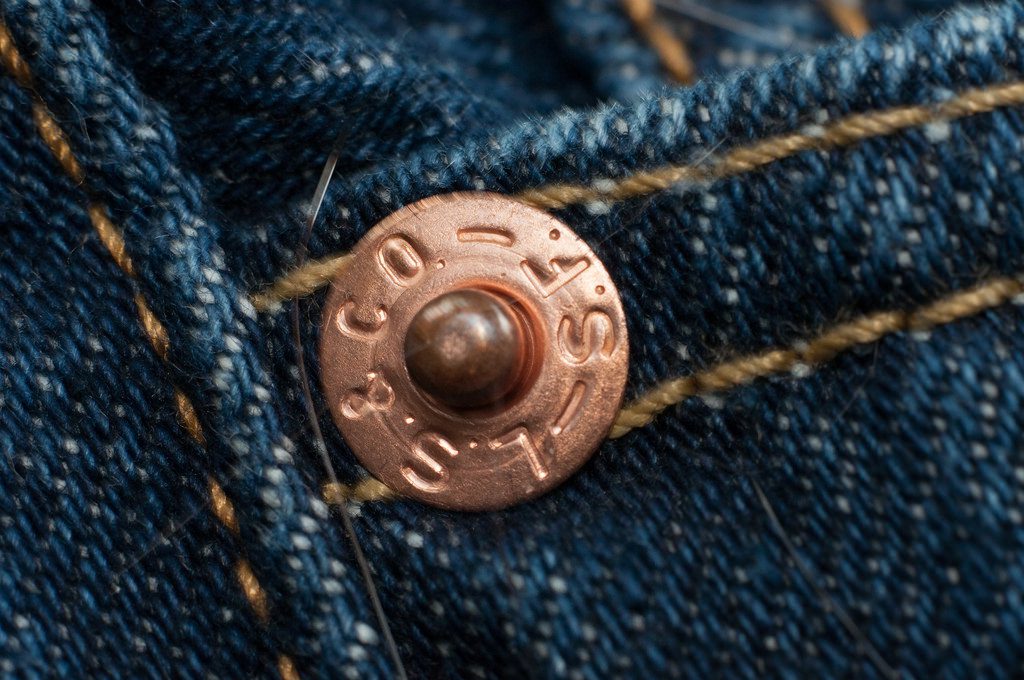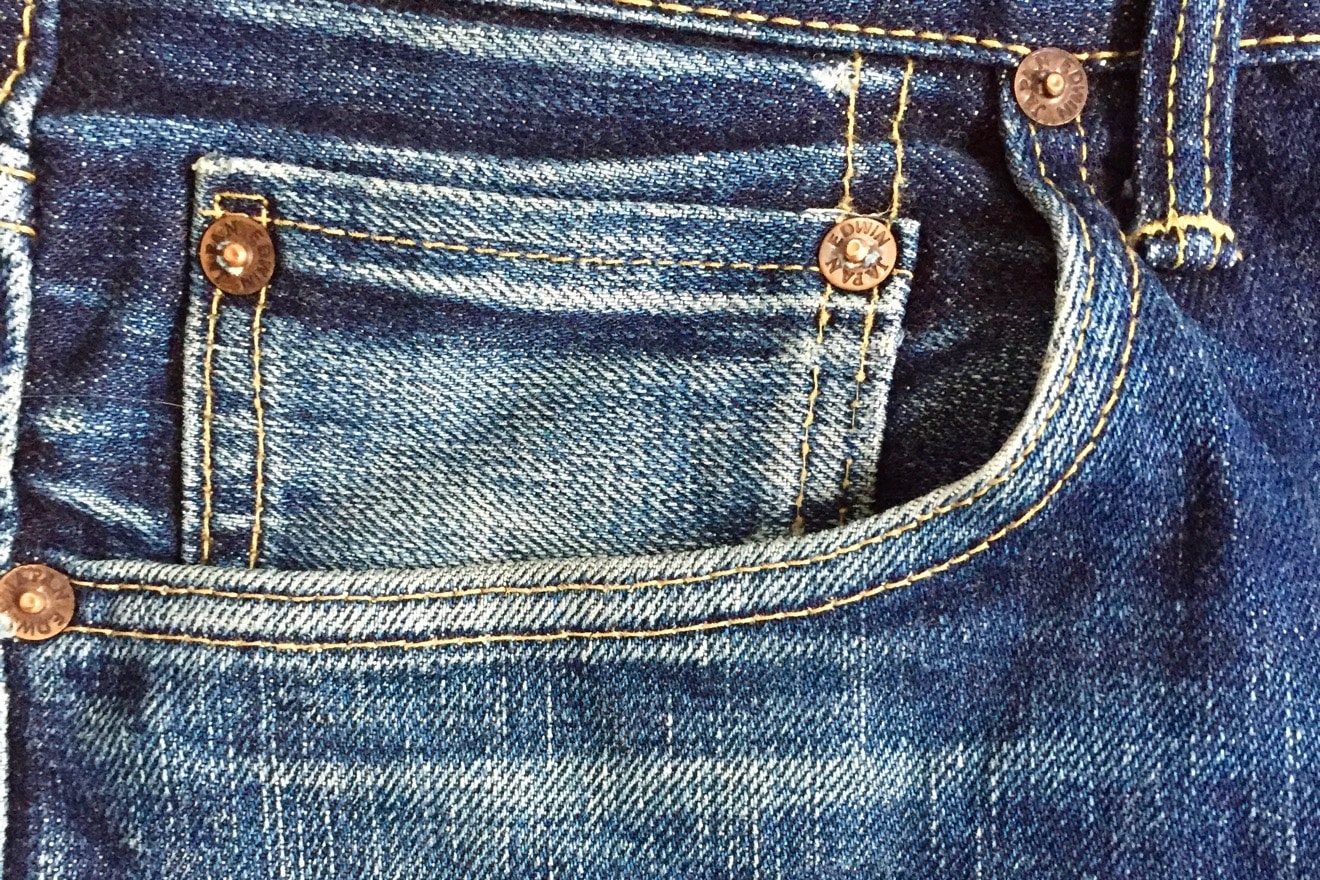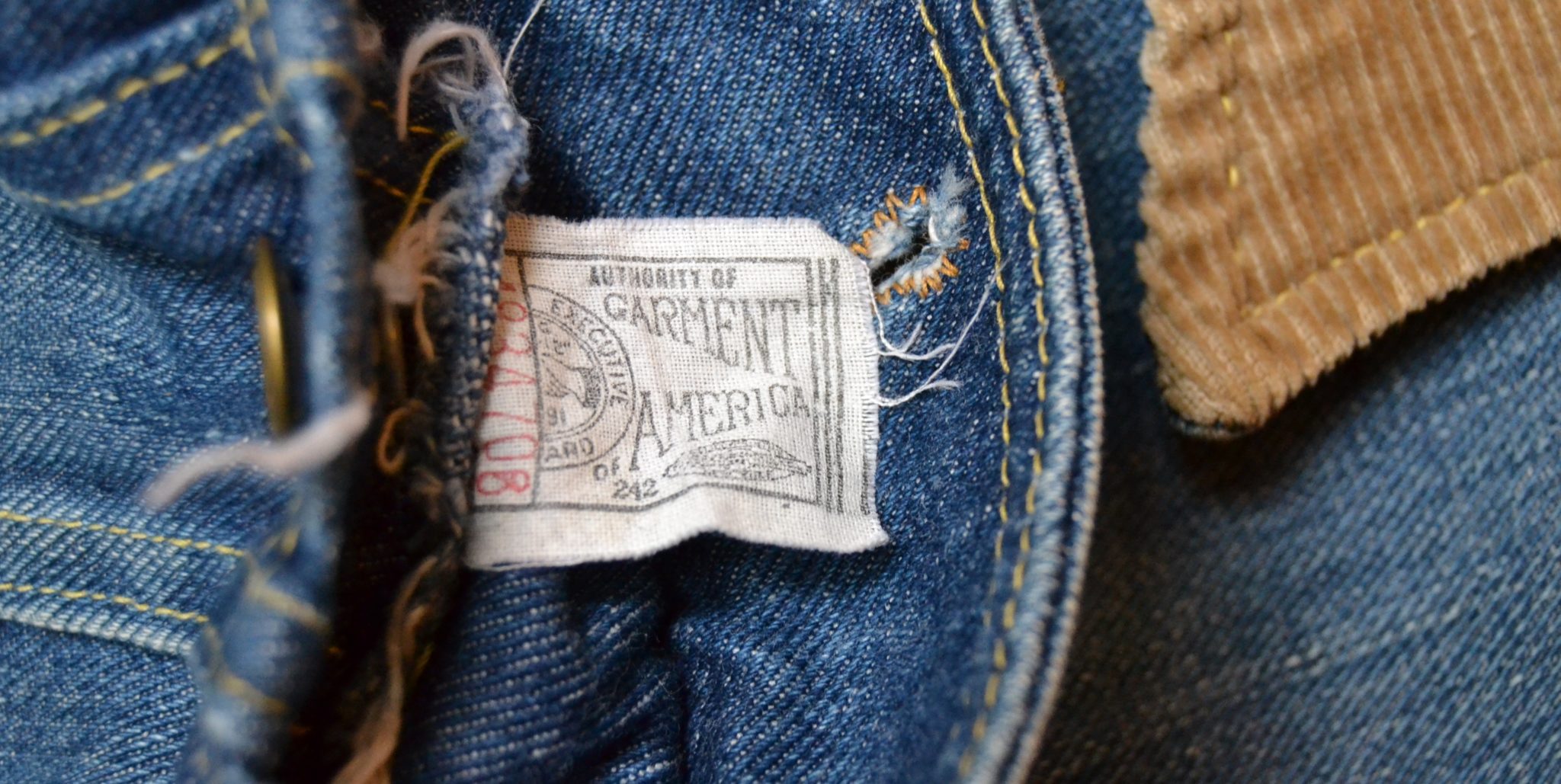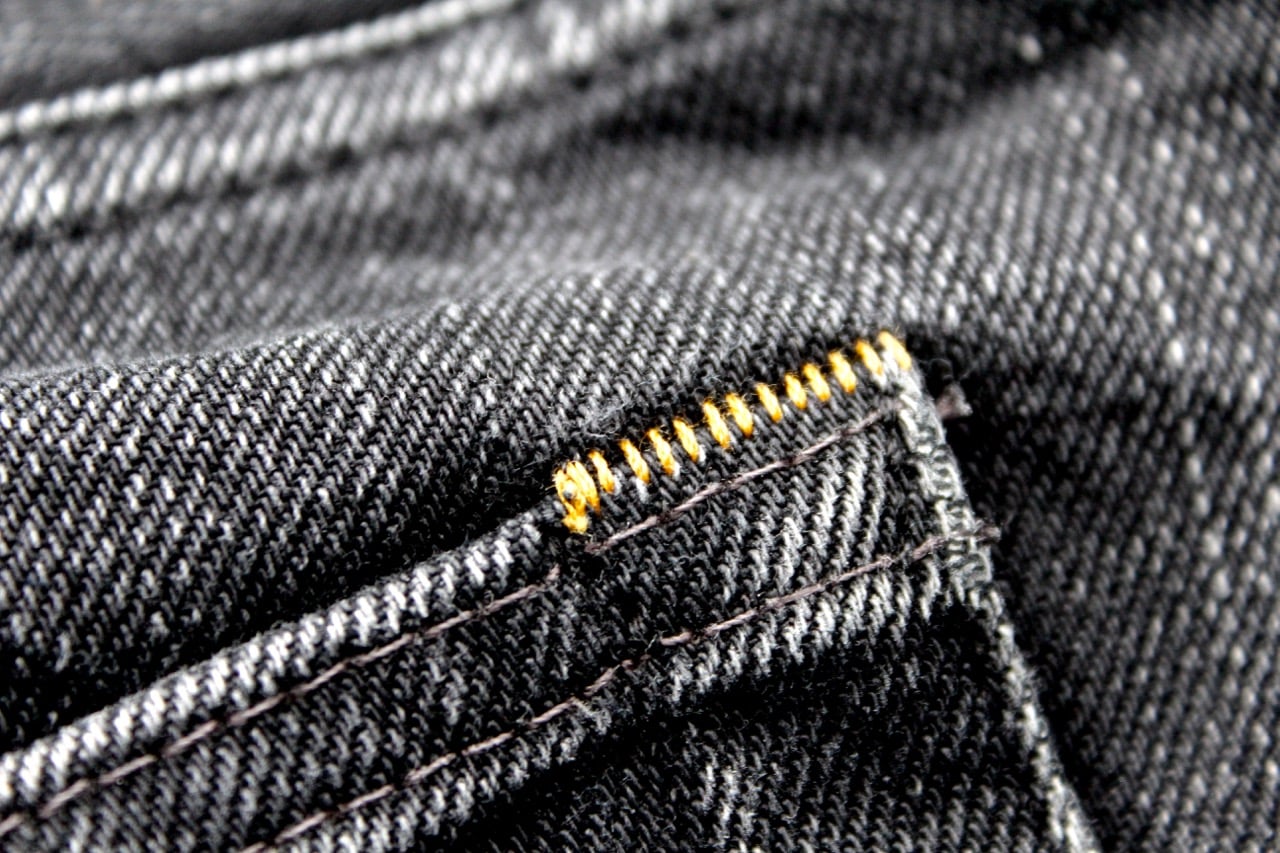The History and Relevance of Small, Yet Iconic Brand Elements That Define Jeans Makers
In a commoditized industry where hundreds, if not thousands of brands compete with incredibly similar products, how a brand distinguishes itself falls down to only a handful of factors, such as cut, quality and most tangibly, branding.
Look at a ‘denim wall’ in your local denim store and chances are, you’ll be faced with a sea of neatly folded blue denim. However, if you look a little closer at different pairs, it quickly becomes apparent that denim brands have found incredibly successful ways to distinguish their product from that of their competition.
The first episode of this series discusses the defining features that relate to the durability and practicality of jeans. In this episode, I’ll look at how the addition of small, yet iconic elements are important for brands because they are part of their identities, and because they possess enormous value.
Seemingly trivial features have become icons that help consumers differentiate one brand from another. By understanding the value that consumers place on these branding details, you will be able to better build a narrative for the product to your customers, enhance the desirability of the product and convert a prospect into a customer.
The three episodes in the series about the defining features of jeans focus on:
- Features that make jeans durable and practical
- Features that help you differentiate one brand from another (this episode)
- Features that make jeans fit and add support
The Pioneering Defining Features With Brand Value
To take the world’s most iconic jeans as an example, Levi’s are instantly associated with the little red tab found on the right, back pocket of their jeans.
Interestingly enough, this addition—among many others on a pair of jeans—is only the latest in a number of ‘branding’ features made in order to make their products stand out to consumers.
It All Started With a Rivet
Initially used as a reinforcement on crucial stress points, the copper rivet greatly extended the durability and lifespan of a pair of denim waist overalls. Incidentally, the Levi’s brand and their jeans became synonymous with high quality and as such, began to dominate the market.
In fact, the very brand became almost synonymous with work overalls in general. Being under patent meant that Levi’s was the only company legally able to produce riveted workwear until the patent’s expiration in 1892. The sudden explosion of copycat riveted overalls is a testament to how effective a branding tool this detail was in ensuring Levi’s domination of the workwear market.
The copper rivet that started it all off was a successful (if somewhat incidental) branding strategy. It associated a brand’s garment with quality. This is a sentiment that has extended through the ages right to the present day. It becomes evident when reading the product descriptions of jeans from nearly every brand, which pride durability as a defining trait of the product.
From the very beginning, LS&Co stamped their brand name and patent on each individual rivet as they understood the value customers placed on garments featuring this innovation.
Branding Your Back Pockets
All the way back to 1873, Levi’s waist overalls also featured a dual ‘seagull’ design, known as an arcuate, on the single back pocket. Whether or not this was the result of one brand’s success with the feature as a branding tactic or a way of reinforcing the pocket integrity on a workwear garment is up for debate. However, this feature has, like the copper rivet, become synonymous with jeans through the ages.
The placement of both the rivet and arcuate is quite universal, across eras and models. As a feature rooted in functionality, it is logical that rivets, regardless of brand, would be placed at crucial stress points like at the corners of pockets and at the bottom of the fly.
With the advent of bartacking as a cheaper alternative, the back pocket and fly rivets have been consigned to history. However, many brands continue to place rivets at the corners of the front and watch pockets simply for their beauty, and to adhere to the iconic look of the 5-pocket jean.
Whilst the back pocket arcuate does not add to the durability of a product, like the rivet, it’s near total inclusion on every pair of jeans suggests that it could have served as a way to allow a predominantly illiterate consumer base to distinguish between brands and build customer loyalty.
However, competing brands like Lee and Wrangler, to name but a few, also had arcuate stitches on their back pockets all the way up to 1943 when Levi’s trademarked the design.
The expiration of LS&Co’s rivet patent in 1890 saw the flourishing of several other details that would appear on a pair of jeans, all in order to help distinguish one brand from another.
Visually Depicting Durability With a Branded Patch
The fact that the evolution of the jean and the accompanying branding is saturated with references to Levi’s is testament to the pivotal role the brand played at the dawn of the modern jean. The company’s desire to stand out from and dominate their market lead to innovations such as the brand patch.
With their competitors duly adorning Levi’s’ products with arcuates and rivets at stress points, Levi’s chose to visually depict the durability of their product through the ‘Two Horse’ design on a leather patch situated at the waistband of their overalls.Featuring two horses trying in vain to rip a pair of their jeans, it symbolically shows the durability of the garment. Literally, two horses couldn’t ‘pull ‘em apart’.
Featuring two horses trying in vain to rip a pair of their jeans, it symbolically shows the durability of the garment. Literally, two horses couldn’t “pull ‘em apart.”
The idea of denim garments being so tough that they can’t be ripped is, incidentally, not an idea unique to Levi’s. Founded in New York in 1871, Sweet-Orr’s branding features a tug of war on their back pocket with a pair of their jeans replacing the traditional rope. Garments with this design were being sold a whole fifteen years before Levi’s placed their patch on their jeans.
With the market for miners essentially dominated by Levi’s, their competitors Wrangler and most importantly Lee set their sights on the ranchers and cowboys of the Midwest—an industry that was rapidly growing in the early 20th Century.
H.D. Lee Mercantile Company, as it was known back then, quickly saw the value in adding a brand patch to their jeans. Essentially every pair of their jeans could be turned into an advertisement. Lee opted to brand their brand patch on a piece of untreated hide complete with hair with their brand, literally branded onto it.
This small piece of leather essentially defined their target market: the men and women who made their living on horseback herding cattle. Their most iconic jean—the Rider—was synonymous with a life lived on the back of a horse.
One could also argue that the growth in popularity of denim as the garment of choice for horsemen also contributed to the addition of the brand patch: when sitting in the saddle, the arcuate on the back pockets would be essentially invisible, rendering the jeans generic.
Understanding that their monopoly on riveted garments would end with the expiration of the patent that gave them their first unique branding, Levi’s began exploring a number of new ways of making their products stand out, many of which endure to this day as staples of jeans branding.
If You Can’t Patent It, Trademark It
The Levi’s waist overalls, known simply as ‘XX’ for the first 17 years, were reborn as the 501 when the patent for rivets expired. This meant that customers purchasing their denim goods could ask for a specific garment rather than simply asking for denim overalls and risk purchasing from Levi’s’ competitors.
Nowadays, “501” is a branding feature loaded with meaning: as the most iconic jean in the world, 501 has evolved from simply meaning a top-of-the-line product to one loaded with socio-political values. 501 implies rockstars, activists, rebels and Hollywood movie stars.
As almost all competitors adopted the rivet, LS&Co had to adopt new elements to their products in order to differentiate them in the marketplace. One such feature has stood the test of time and still adorns the back pockets of many pairs of jeans today.
The Famous Red Tab
The evolution of denim is characterised by small innovations over the years: rivets have been added and taken away, suspender buttons made way for belt loops and the cinch has become a symbol of nostalgia.
It’s no surprise then that branding across a pair of jeans has also been subtle. Small though they might be, brands understood that it was precisely these details and features that customers would come into a store and ask for.
In 1936, Levi’s introduced another detail to their denim that would become a defining feature of denim in general: the red tab. Sticking out from behind the right back pocket, and adorned with the branding ‘LEVI’S’, the small red flash stood out vividly from the dark blue denim and instantly became synonymous with the Levi’s brand.
In fact, the strength of Levi’s’ branding as a way of distinguishing their product in the marketplace was so effective that the company trademarked their arcuate, leather patch design and red tab. This meant their competitors could no longer adorn their products with the same or even similar design.
Yet the brand patch and arcuate had already become synonymous with a pair of jeans. This resulted in Lee’s famous ‘lazy S’ and Wrangles ‘double W’ back pocket designs that have remained on their jeans ever since.
Even during wartime, when superfluous or redundant elements to any garment were removed in order to conserve crucial materials such as thread and metal exclusively for the war effort, brands adapted rather than dropping ‘non-essential’ elements to their garments.
Rather than lose their trademark arcuate and brand patch, brands like Levi’s adapted to their circumstances and began painting arcuates onto their pockets and switched their brand patch from leather to an analogous cardboard substitute. For a garment born during hard times, jeans brands were no strangers to adapting their branding to fit the requirements of the day.
The Pocket Flasher
With the market for denim workwear exploding after WWI, the number of denim brands and manufacturers grew significantly, the majority of whom, followed the classic format for jeans that endures today.
It was in 1937 that another jeans branding staple was introduced: the back pocket flasher. Initially adopted by Levi’s, the flasher highlighted the continued presence of their rivet reinforcement on back pockets, which were now being attached under the top fold of denim. This was the result of customers complaining that the rivets would scratch their furniture and saddles.
The flasher featured two arrows pointing to the hidden rivets ensuring “The Rivet’s Still There!” to reassure customers that the quality of earlier models endured in the more modern jeans. The flasher also became a convenient canvas to highlight the 501 mark, which was already established as a symbol of quality and durability.
The adoption of the back pocket flasher became almost ubiquitous throughout the jeans industry: companies like Lee have used the flasher of their iconic Rider model to evoke the lifestyle that they were designed for; a cowboy taming a wild mustang. With the popularity of dude ranches in the mid-20th century, Lee could evoke the frontier spirit in their strongest market: young, city-dwelling men.
The back pocket flasher is another jeans branding element that has withstood the test of time, and even the original designs have proven to be so influential that modern brands continue to draw inspiration from them. Take for example Studio d’Artisan’s flashers, which features similar arrows pointing to hidden rivets on their own garments, and pay subtle homage to the spade-shaped flasher of Lee’s cowboy jeans.
Every Element of the Garment Is a Branding Canvas
From early on, jeans makers understood that not all branding needed to be visible when the garment was worn. Equally important was the branding that would be visible when a potential customer would be considering to purchase.
Convincing a customer of the garments value was especially important before the advent of mass-produced denim that dominated the later half of the 20th century. Maker thusly took to using every part of the garment, including pocket bags and the denim itself to reassure their customers.
Brand-Specific Denim
Nowadays we associate selvedge as a hallmark of denim of the highest quality. Whilst not trademarked, selvedge IDs are often unique to specific mills, many denimheads take into consideration the selvedge when purchasing a pair of jeans as a signifier of the weight and mill from which the denim came from.
Many brands have, in the past, had close relationships with certain denim mills, and would often exclusively source their denim from one mill. This intimate relationship can be seen nowhere better than the over 100-year-old partnership between LS&Co and Cone Denim in North Carolina.
At the advent of the jean in the early 20th century, all denim was produced on shuttle looms and featured ‘self-finished’ edges in the same undyed white thread used in the weft of the fabric.
In 1915, Levi’s started transitioning the sourcing of their denim, moving from Amoskeag to Cone Mills and featured the world-famous redline selvedge ID—the thin red line that adorns the ‘self-finished’ edges of denim made on shuttle looms.
Because of their relationship, this redline selvedge became an unofficial calling card of Levi’s jeans.
As sanforized—or pre-shrunk—denim was only developed and patented in 1930, prior to this all denim would have to be shrunk to fit. Workers would often cuff or turn up their jeans during the shrinking process and this meant they displayed the red line along the selvedge, showing they were wearing a pair of Levi’s.
The redline was, in fact, originally a way to make it easier for mills to distinguish the denim made for one maker from that made for another. And with these colour codes for denims destined for specific brands, even illiterate workers at the factory could distinguish them.
Still, brands understood how even the smallest of details, like the ID on the selvedge, could enhance the branding power of a pair of jeans and developed their own colour ID for their garments. Take Lee, for example, who originally used a yellow thread in their selvedge to distinguish their garments from Levi’s’.
Pocket Bags
Often visible only to the wearer, the pocket bags on jeans have long been an extra canvas on which makers can further promote their brand. As early as 1890, Levi’s were printing the pocket bag of the left front pocket with their famous ‘two-horse’ logo along with the immortal slogan:
For over XX years Our celebrated XX Blue Denim Copper riveted Overalls have been before. THIS IS A PAIR OF THEM!”
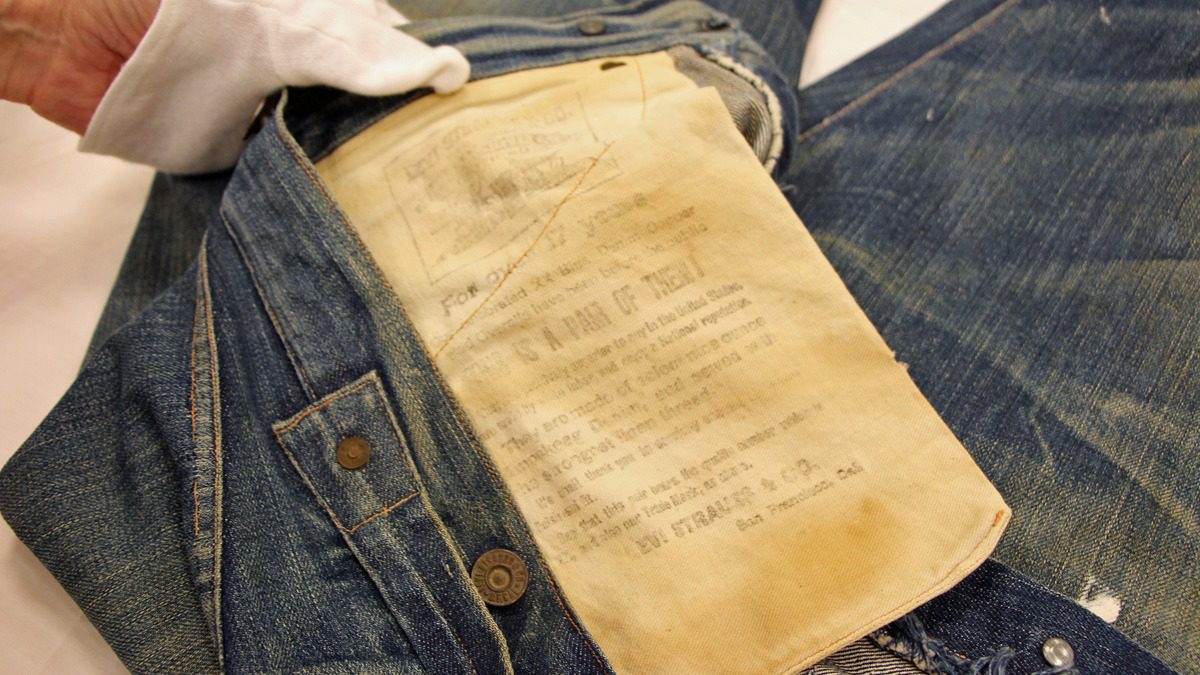
In 1890, Levi’s had been proudly manufacturing their jeans for over 17 years. Today, they boast an astounding 127 years of jeans manufacturing.
A printed pocket bag is something that is almost universal across jeans brands today. It forms a canvas where makers can promote their values and ethos, reinforce the quality of their products or even include information on the materials used.
Iconic Branding Worth Copying
Small, subtle branding features such as the arcuate, rivet and red tab are important not only because of their tangible, practical aspects, but arguably even more so because of the intangible values associated with them.
The entire ethos and imagery that stands behind a brand are expressed through these small details that adorn a pair of jeans: the gruelling life of a minor or labourer implied in the toughness of the garment they required, the life of a rancher epitomised with a branded horse hide leather patch.
Nowadays, jeans have attained the title of the most iconic garment ever. If you compare a pair of modern jeans to some produced in the 1950s, whilst the cut and fit might have changed, the placing of branding remains constant.
Newer brands may have moved on from a back pocket design that is reminiscent of an arcuate, but we see very few brands that leave the back pockets devoid of any sort of design. Take a look at a pair of Nudie jeans: the back pocket design is a far cry from a dual-line arcuate stitched with a single needle. Their very unique, new design nevertheless pays homage to the idea that a pair of jeans has decorative back pockets.
Japanese jeans manufacturers have long been famed for keeping the traditional denim industry alive, even as it faced extinction in its birthplace in the United States. Such was, and still is, their attention to detail when reproducing period-accurate jeans that big brands have kept a watchful eye to ensure that their trademarks aren’t being infringed upon.
Back in 2010, Levi’s took legal action against Evisu over an infringement of their arcuate design. In 2007, they presented numerous lawsuits against other brands such Iron Heart and Studio d’Artisan for having back pocket patches that were too similar to Levi’s’ own. In fact, Levi’s desire to protect jean elements that are “inherent” to their brand was so strong that they were incredibly specific about what was considered infringement and what was fair game:
1.There are to be NO tabs attached between two pieces of fabric on the rear pockets, 2. The cards hanging out of the back pocket, stapled to the pocket, must not look anything like vintage/modern Levi’s Info Cards, 3. Arcuates on the rear pockets must not resemble the Levi’s arcuate in ANY way shape or form, 4. Rear leather patch cannot contain an image of two moving objects (horses, motorcycles, pigs, etc..) pulling apart a pair of jeans”
Wherever people’s opinions may lie on the circumstances of these actions, it nevertheless highlights the selling power that these branding features still possess today.
If you remove the small but critical branding features from a pair of jeans: the red tab, the back pockets designs, the stamp on the buttons and zipper, what really sets one pair of jeans apart from another?
In today’s day, jeans are no longer built with durability at the front of mind. Jeans sport branding that allows the wearer—the consumer—to identify with a certain look or subculture that they feel an affinity towards.
The next episode in the series about the defining features of jeans discuss the different elements that support the garments and “holds up the trousers.”
On the Hunt For Raw Selvedge Jeans?
Launched in 2011 by Thomas Stege Bojer as one of the first denim blogs, Denimhunters has become a trusted source of denim knowledge and buying guidance for readers around the world.
Our buying guides help you build a timeless and adaptable wardrobe of carefully crafted items that are made to last. Start your hunt here!
Share